A telescope engineer inspects a receiver slotted into the cage at the Green Bank Telescope’s Prime Focus. This is where the radio waves come together after they have reflected off of the telescope’s 100-meter dish.
The GBT’s huge metal feed arm towers 200 feet above the dish, ending in a retractable boom at the Prime Focus. Radio waves can pour directly into a receiver like this one cradled in a metal-framed box on the boom. The boom can tilt and twist to align the receiver perfectly to the incoming waves.
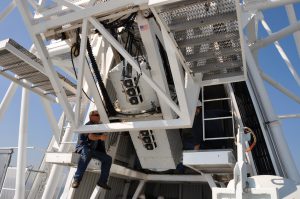

Prime Focus Feed Horn
A telescope engineer readies a feed horn to funnel radio waves into a receiver on the Green Bank Telescope’s Prime Focus. This is where the radio waves come together after they have reflected off of the telescope’s 100-meter dish.
The GBT’s huge metal feed arm towers 200 feet above the dish, ending in a retractable boom at the Prime Focus. Radio waves can pour directly into a receiver cradled in a metal-framed box on the boom. The boom can tilt and twist to align the receiver perfectly to the incoming waves.
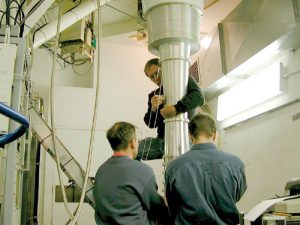
Installing a Receiver on the GBT
On a floating platform suspended from the 64-foot high feed arm on the Green Bank Telescope is the room that houses its eight receivers. In this photo, a large feed horn for a long wavelength receiver is being steadied so that a cryogenic pump can be attached. The supercooled receiver will collect the waves funneling down this horn and send them along fiber to the computers nearly two miles away in the noise-shielded control room.
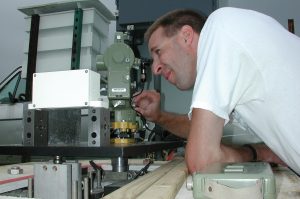
Aligning the GBT Quadrant Detector
John Shelton, an engineer at Green Bank, uses a transit scope to align the quadrant detector under the dish of the Green Bank Telescope. In order to measure the precise amount of movement of the feed arm due to wind, and to temperature and gravitational fluctuations, engineers installed a rangefinder and mirror system beneath the surface of the dish. The rangefinder is on the feed arm and points directly through a hole in the dish surface. There, it is reflected by a mirror into a measurement device that compares all relative movements of the feed arm that affect the distance measured by the ranger.
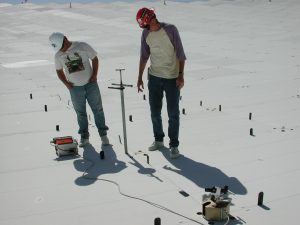
Shaping the GBT’s Surface
Telescope Technicians J. D. Nelson and Nathan Sharp examine the position of one of the Green Bank Telescope’s 2004 surface panels. Their goal is to get the entire surface shaped into a section of a perfect parabola, so that it will reflect radio waves precisely to a point 200 feet above it, called the prime focus.
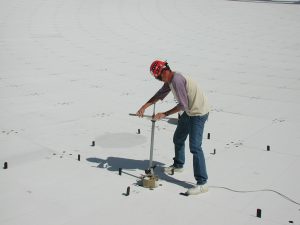
Aligning the GBT Panels by Hand
Telescope Technician Nathan Sharp uses this panel adjustment tool to slightly change the position of one of the Green Bank Telescope’s 2004 surface panels. His goal is to get the entire surface shaped into a section of a perfect parabola, so that it will reflect radio waves precisely to a point 200 feet above it, called the prime focus.





